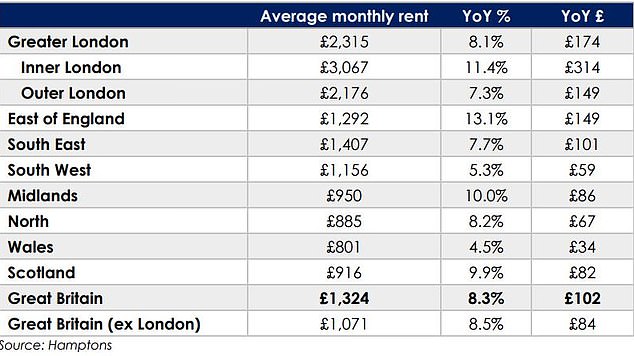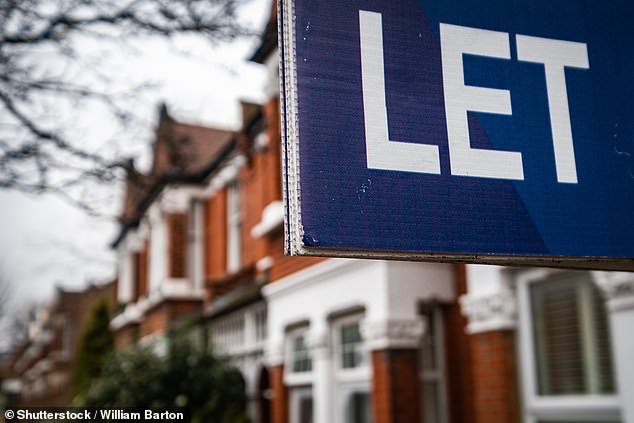In Britain, rents fall for the third month in a row – and in London prices fall by 5%: here’s why
After three years of double-digit rent increases, the rental market finally appears to be cooling down.
According to the HomeLet Rental Index, rental prices in Great Britain have fallen for the third month in a row. This index uses tenant reference data from more than one million tenants per year.
This shows that average rents fell by 0.6 percent in January, after a decline of 0.9 percent in December. Since October, the average rent has fallen from €1,283 per month to €1,260 per month in January.
This follows three years of dramatic month-on-month increases, which saw the average rental price increase by 32 percent between October 2020 and 2023, from £974 to £1,283 per month.
HomeLet says that average rents fell in January in every UK region, except the East Midlands, West Midlands and the South West.
Slowing down: In January, average rents for newly rented properties in the UK rose at the slowest pace in 13 months, according to Hamptons
HomeLet’s figures are consistent with data released by Hamptons today.
The property company revealed that average rents for newly let properties have risen at the slowest pace in thirteen months, up 8.3 per cent year-on-year across Britain.
This marks a change in pace from 2023, when rental growth peaked at 12 percent in August and slowed slightly to 10.2 percent in December.
Hamptons says 59 percent of landlords achieved a higher rent last month when a new tenant moved in, compared to a peak of 81 percent in January 2022 and 79 percent in January 2023.
Aneisha Beveridge, head of research at Hamptons, said: ‘Last summer appears to have been the peak for rental growth.
‘Since then, fewer landlords have increased rents. Where this was the case, the monthly increases, in cash terms, were in double rather than triple digits.”
We have decided to contact a number of rental agents in Great Britain to see if they also see the rental market cooling down.
Lorraine Ashelby, director of lettings and property management at Countrywide in Scotland, said: ‘We have noticed a slight shift in rental prices in central Glasgow and surrounding markets.
‘This market is constantly changing and we currently see the need to reduce rents, albeit cautiously.
‘Where we previously saw rents rise by up to 30 percent above market value as a result of exceptional demand, we now see that demand is equal to supply and that many tenants are not prepared to pay more than market value.
‘In addition, tenants expect a very well presented property when they pay the top prices on offer in the city.
‘In our remote branches, which cover the west coast to Dundee, rental prices are very subtle and remain flat in many areas.’

More choice: There are 34% more rental properties on the market today than around the same time last year, but 43% fewer compared to the same time in 2019, according to Hamptons
Angela Davey, head of rental at Peter Alan in Wales, says that while rents in the cities continue to rise, rents in smaller towns and rural areas are starting to level off.
She said: ‘Average rents are still at record levels here in Wales, but the latest growth rates have been the lowest since pre-pandemic, and early signs suggest that the annual rate of rental growth will slow further in 2024.
‘Despite the current trend of modest rental growth in Wales, specific locations in the country are showing more pronounced fluctuations.
‘In particular, urban centers and areas with high demand for rental properties, such as Cardiff, are witnessing relatively higher rental growth rates.
‘On the other hand, rural areas and smaller towns may see slower rental growth or even stagnation, with growth rates below the national average.’
Meanwhile, Matthew Hardwick, rental branch director at William H Brown in Lincoln, says rental demand depends heavily on the type of property.
Hardwick said: “In the Lincoln area we are still seeing overall rental prices rise, but we are seeing that certain property types may see a slight decline simply due to lower demand.
‘For example, there is currently less demand for a larger house with four or five bedrooms and therefore the price is more likely to fall than for a property with two or three bedrooms. These are our bread and butter properties for which rents continue to rise because there is much more competition between tenants.”
Why are rents falling?
Over the past three years, much attention has been paid to the fact that there are not enough properties available to rent to meet growing tenant demand.
However, it appears that this imbalance is finally starting to tip in favor of tenants.
Hamptons says there are 34 percent more rental properties on the market today than at the same time last year.
This is mainly a reflection of the longer time it takes to rent out a property, rather than a large increase in the number of new rental properties coming onto the market.
However, a shortage remains. For example, there are still 43 percent fewer rental properties compared to the same period in 2019 – before rents skyrocketed.
“The magnitude of mortgage rate increases set off two years of record-breaking rental growth. Because landlords have abolished fixed terms, they have partly passed on these higher costs to tenants in the form of higher rents.
‘While upward pressure on rents appears to be easing in 2024, especially since mortgage rates have fallen, the increased pressure on landlords means rental growth will remain persistent.
‘Reduced returns combined with the additional time and financial costs resulting from rental reforms have put pressure on the number of new landlords. It looks like rent growth will outpace inflation this year.”
Rent declines in London are leading
The rental market in the capital currently appears to be cooling down the fastest.
According to Hamptons, annual rental growth in the capital more than halved between August and January, from 17.1 percent to 8.1 percent, meaning rent growth is the slowest in two years.
The average monthly rent for a home in Greater London has fallen by more than £100 per month, from a high of £2,192 per month in October to £2,081 per month from January – a fall of 5 per cent.
Here too, it is likely that an increasing number of available rental properties will help lower prices in the capital.
According to London rental agent Chestertons, there are currently 41 percent more rental properties available in London than in January 2023.
With more properties on the market, renters will have more choice and less pressure to make a quick decision, according to the report.

Still Up: Although average rents have fallen, they still remain much higher than a year ago
Data from Rightmove backs this up, showing that the average length of time a property is listed on the platform before being rented or listed has risen from 33 to 39 days.
This has led to more and more landlords lowering asking prices to attract tenants.
Adam Jennings, head of leasing at Chestertons, said: “We have seen a significant increase in landlords putting their properties on the market, having been attracted by the substantial rent increases over the past eighteen months.
‘This influx of properties has led to more choice for tenants and as a result many landlords have decided to lower their rental expectations.
‘We anticipate that the number of available rental properties will continue to grow in 2024, causing rental levels to adjust further.
‘While this does create more favorable market conditions for tenants, London still has one of the most competitive rental markets around and we advise tenants to start their search as early as possible.’
What now with the rental prices?
Despite positive news for tenants, HomeLet experts believe that this is not the start of a downward trend.
In fact, HomeLet experts still predict that rental costs could increase by another 5 to 10 percent by January 2025.
Andy Halstead, CEO of HomeLet and Let Alliance, said: ‘While we can be absolutely positive about these short-term gains, it is not yet time to celebrate.
‘On the one hand, it is great to see that rental prices continue to fall month after month, and by the largest volume in years.
‘But on the other hand, we also know the market and are well aware of the external factors that could influence it in the coming months.’

HomeLet’s experts still predict that rental costs could rise by another 5 to 10 percent by January 2025
Halstead added: ‘Of course, marginally lower rents will put a little more money in tenants’ pockets and partly reduce the likelihood of defaults, but the wider landscape is still incredibly challenging for all parties – with little sign of relaxation.
‘In fact, after last year’s trajectory, it is entirely possible that rents will be 5 to 10 percent higher this time next year.
Unless we see some dramatic changes in the economy, 2024 looks set to bring more of the same.
‘Landlords will face a familiar range of problems, including rising costs and prohibitively expensive mortgage rates.
‘I will be keeping a close eye on the Spring Budget next month to see what support is being offered to tenants and landlords.’
Some links in this article may be affiliate links. If you click on it, we may earn a small commission. That helps us fund This Is Money and keep it free to use. We do not write articles to promote products. We do not allow a commercial relationship to compromise our editorial independence.


